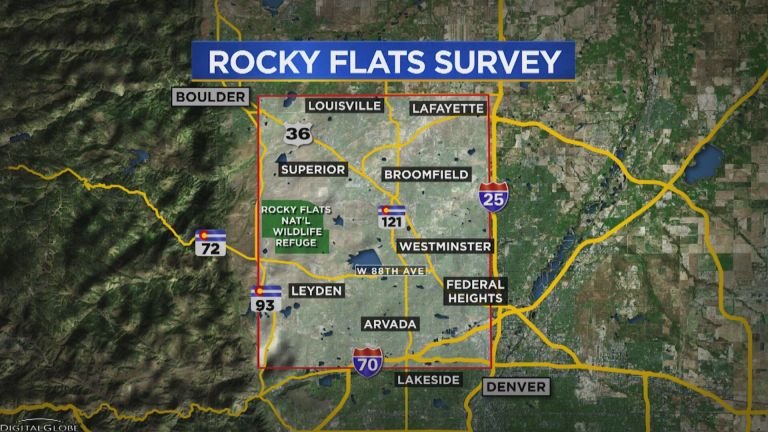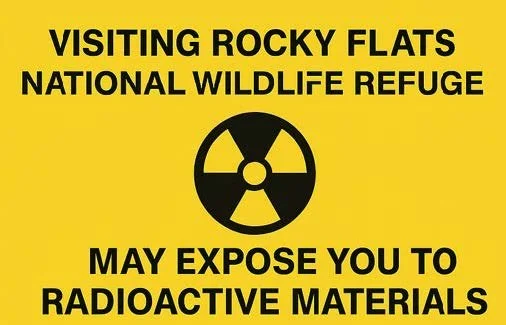Rocky Flats Right to Know
Rocky Flats Right to Know is an organization dedicated to educating the public about environmental and health risks stemming from the Rocky Flats nuclear weapons facility. Originally founded by two grandmothers from Arvada (Bonnie and Marian), it has evolved into a collective of groups dedicated to addressing the ongoing challenges posed by Rocky Flats. The organization's mission is to provide a central platform for people to learn, engage, and take action.
The collective draws on a wealth of expertise and experience, including scientific research, firsthand accounts, advocacy dating back to the1970s, and the work of nonprofits and community activists. Rocky Flats Right to Know serves as a vital resource for anyone seeking to understand the history and continuing impacts of Rocky Flats, connect with related organizations, and participate in their efforts.
What is Rocky Flats?
Rocky Flats was the United States’ primary nuclear weapons production facility, responsible for manufacturing an estimated 70,000 plutonium “triggers” for thermonuclear bombs. During its operation, the plant experienced numerous accidents, including fires, leaking barrels, and improper waste disposal that spread contamination beyond its boundaries. Despite a multi-billion-dollar cleanup of the "Central Operable Unit"—an ongoing Superfund Site off-limits to the public—large portions of the site, now a national wildlife refuge, and surrounding areas remain contaminated with plutonium and other toxins, posing ongoing environmental and health risks.
_____________________________________
Rocky Flats Downwinders Community Health Survey
Rocky Flats Downwinders is actively conducting a community driven health survey with the following objectives:
-To obtain an idea of the health of the community surrounding the Rocky Flats Nuclear Weapons Plant with consideration of the time frames during operation, during “clean up” and post “clean up”.
- To provide a forum for Rocky Flats Downwinders to document their health issues and the health issues of family members.
- To collect data in order to map cancers, epilepsy, autoimmune diseases and other health and reproductive problems near Rocky Flats.
_____________________________________
Urge FOR InFORMED-CONSENT ‘WARNING’ SIGNAGE AT ROCKY FLATS
Background: Since the 2004 draft EIS, the majority of the public has opposed recreation at Rocky Flats. For over 20 years we have engaged in public education and advocacy to warn people about the dangers of contaminants that remain downwind from accidents and illegal activities during nuclear weapons production at the Rocky Flats Plant. Despite sustained public opposition - and despite the fact that the refuge has never been remediated - the federal government chose to open the Rocky Flats National Wildlife Refuge to the public in September 2018. This site remains contaminated, and we continue to oppose both recreation and commercial or residential development near Rocky Flats.
The Town of Superior, Broomfield City Council, and Westminster City Council have been strong advocates on behalf of public health by opposing the Rocky Mountain Greenway’s construction through Rocky Flats. However, Jefferson County, Boulder County, the city of Arvada, and the federal government continue to forge ahead with construction of recreational infrastructure at Rocky Flats.
It’s more important than ever to oppose the Rocky Mountain Greenway trail through contaminated land and demand informed consent signage Please contact Jefferson County, Boulder County, and the city of Arvada and encourage them to protect their citizens by opposing the trail and installing warning signage at Rocky Flats so visitors are not unknowingly exposed to toxic and radioactive materials.
Arvada City Council : council@arvada.org
Lisa Simpson, Mayor: lsimpson@arvada.org
Randy Moorman, Mayor Pro Tem - Councilmember: rmoorman@arvada.org
Shawna Ambrose, Councilmember: sambrose@arvada.org
John Marriott, Councilmember: jmarriott@arvada.org
Bob Fifer, Councilmember: bfifer@arvada.org
Sharon Davis Councilmember at-large: sdavis@arvada.org
Brad Rupert Councilmember at-large: brupert@arvada.org
Jefferson County Commission: EMAIL FORM
Tracy Kraft-Tharp, Commissioner: tktharp@co.jefferson.co.us
Andy Kerr, Commissioner: akerr@co.jefferson.co.us
Lesley Dahlkemper, Commissioner: ldahlkem@co.jefferson.co.us
Sarah Roddis, Executive Assistant: <sroddis@co.jefferson.co.us
Rachel Brenna, Strategy and Planning Director: rbrenna@co.jefferson.co.us
Boulder County Commission: commissioners@bouldercounty.gov
Ashley Stolzmann, Commissioner: commissioner.stolzmann@bouldercounty.org
Claire Levy, Commissioner: commissioner.levy@bouldercounty.org
Marta Loachamin, Commissioner: commissioner.loachamin@bouldercounty.org
Boulder City Council: EMAIL FORM
Aaron Brockett, Mayor: brocketta@bouldercolorado.gov
Nicole Speer, Mayor Pro Tem: speern@bouldercolorado.gov
Taishya Adams, Council Member: adamst@bouldercolorado.gov
Lauren Folkerts, Council Member: folkertsl@bouldercolorado.gov
Tina Marquis, Council Member: marquist@bouldercolorado.gov
Ryan Schuchard, Council Member: schuchardr@bouldercolorado.go
Mark Wallach, Council Member: wallachm@bouldercolorado.gov
Tara Winer, Council Member: winert@bouldercolorado.gov
Westminster, Broomfield and Superior are now considering signage at Rocky Flats but they need our continued encouragement. Please reach out to these communities and urge them to do the right thing by installing clear, visible warning signage for all visitors.
Quotes from Westminster City Council:
Councillor Ireland: "We need to quit erasing our history in this country" "We need to have signage that tells the truth" "I'm tired of the hiding, I'm tired of what has happened with our government in so many ways, that they're not being honest with the citizens of this country, and so I will be voting my conscious."
Councillor Hott: "I always vote my values when I'm up here. I need to be able to sleep at night. And public health and safety are very important to me."
Councillor Carmelia: "This is a case of unusual paramount and involves the health and safety of our community. I cannot undo what previous decision makers have done. I can however make a stand for what is so clearly the right thing to do. I want to emphasize again that this is a historical vote. In my mind this might be the most significant vote I make on my tenure on Council."
Councillor Ezeadi: "I think we all know what the truth has been in this area, legacy contamination still presents a risk despite the surface level cleanup efforts." "I think we have a moral obligation to get out of this."
Westminster City Council : EMAIL FORM
Nancy McNally - nmcnally@westminsterco.gov
Claire Carmelia - ccarmeli@westminsterco.gov
Kristine Ireland - kireland@westminsterco.gov
Obi Ezeodi - oezeadi@westminsterco.gov
Sarah Nurmela snurmela@westminsterco.gov
Amber Hott - ahott@westminsterco.gov
David DeMott - ddemott@westminsterco.gov
Jody Andrews - jandrews@westminsterco.gov
Superior City Council: towncouncil@superiorcolorado.gov
Mark Lacis, Mayor: markl@superiorcolorado.gov
Jason Serbu, Mayor Pro Tem: jasons@superiorcolorado.gov
Heather Cracraft, Council Member: heatherc@superiorcolorado.gov
Mike Foster, Council Member: mikef@superiorcolorado.gov
Jenn Kaaoush, Council Member: jenk@superiorcolorado.gov
Stephanie Miller, Council Member: stephaniem@superiorcolorado.gov
Neal Shah, Council Member: neals@superiorcolorado.gov
Broomfield City Council: council@broomfieldcitycouncil.org
Guyleen Castriotta, Mayor: gcastriotta@broomfieldcitycouncil.org
Deven Shaff, Mayor Pro Tem: dshaff@broomfieldcitycouncil.org
James Marsh, Council Member: jmarsh@broomfieldcitycouncil.org
Kenny Van Nguyen, Council Member: knguyen@broomfieldcitycouncil.org
Paloma Deldadillo, Council Member: pdelgadillo@broomfieldcitycouncil.org
Austin Ward, Council Member: award@broomfieldcitycouncil.org
Jean Limm, Council Member: jlim@broomfieldcitycouncil.org
Deven Shaff, Council Member: dshaff@broomfieldcitycouncil.org
Laurie Anderson, Council Member: landerson@broomfieldcitycouncil.org
Bruce Leslie, Council Member: bleslie@broomfieldcitycouncil.org
Heidi Henkel, Council Member: hhenkel@broomfieldcitycouncil.org
Todd Cohen, Council Member: tcohen@broomfieldcitycouncil.org
Jennifer Hoffman, City & County Manager: manager@broomfield.org
Nancy Rodgers, City & County Attorney: citycountyattorney@broomfield.org
Planned Rocky Mountain Greenway trail crossings (Points A & B) are currently under construction. Community members are encouraged to urge Arvada, Jefferson County, and Boulder to oppose this project and prioritize public safety.
The Rocky Flats National Wildlife Refuge (5,000+ acres) and surrounding lands (20,000+ acres) have not been remediated. The 1,300-acre Superfund Site inside the refuge is also not protective, with concerns of PFAS contamination in creeks that flow offsite and into drinking water supplies.
Dr. Michael Ketterer’s air samples collected on April 6, 2024, revealed that plutonium particles become airborne and entrained in the wind. The sampling was conducted near the site of the proposed Rocky Mountain Greenway Bridge.
A short-lived sign cautioning residents about plutonium contamination near Rocky Flats. Photographed by Scott Bergers on October 23rd, 2024.
The plotted points indicate areas contaminated with weapons-grade plutonium-239, originating from the 903 Pad at Rocky Flats. This contamination resulted from barrels containing plutonium-laden waste that leaked into the soil. Over time, wind activity redistributed the radioactive particles, spreading them across a wider area and posing ongoing environmental and health risks.
Recent reportable conditions for plutonium highlight ongoing risks from the 903 Pad at Rocky Flats. Erosion of contaminated soil is likely during high wind events, as demonstrated on April 6, 2024, by Dr. Michael Ketterer’s air sampling. Despite these findings, the U.S. Department of Energy (USDOE) has refused requests from regulators to implement measures to control the migration of contamination or to install air monitors.
Remaining subsurface features at Rocky Flats include slabs, basements, tunnels and foundations.
Remaining infrastructure at Rocky Flats include pits and trenches, landfills, ponds, etc.
Three earthen dams (A4 Pond, B5 Pond, C2 Pond) are slated for demolition without dust suppression or air monitoring. These ponds have a history of contamination, and demolishing the dams could release hazardous materials into the environment.












